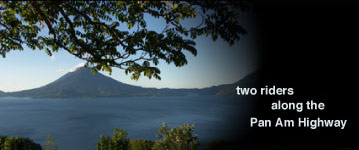
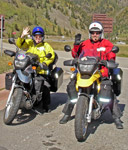
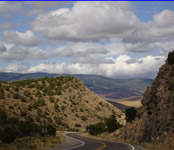
view corresponding gallery | previous entry | next entry
entry 21: galapagos 04/29/06
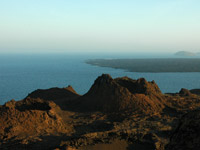 |
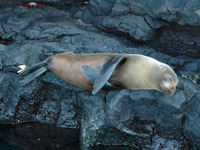 |
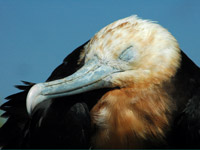 |
Islas Galapagos. In their beginning - violent volcanic eruptions. Today - a living example of peaceful coexistence. For us, well, it turned out to be an adventure of a lifetime. We found a pretty good deal through Safari Tours in Quito, so we booked a “last minute” 8-day cruise on the MV Eclipse - and what we found can only be described as amazing.
The first time I read about these islands I was in the fifth grade, when the concepts of evolution and adaptation were brought to my attention. Next, images of spitting lizards, giant tortoises and sea lions lying about as people walked among them were brought to me courtesy of National Geographic. We (I) could not pass up the opportunity to see these island creatures up-close and personal.
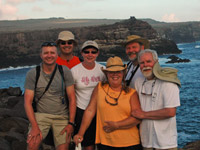 |
| Steve, Gillian, Stan and Jim were the perfect adventurers to share our week with. |
To begin our journey, we flew out to Baltra Island via Guayaquil (largest city in Ecuador) and had our bags closely inspected for foods, plants and animals when we landed. A quick bus ride then took us to our boat – and it didn’t take long to see the wildlife first-hand. As we stepped off the bus we had our first close encounter with sea lions - they had taken over the dock and would not budge. One tourist came within a foot of a big bull and that 400 lb. mammal let out a big bark to let the gentleman know he was too close. Our guide said they rarely bite but several cases a year do involve dumb humans who require stitches after the fact. We took zodiac boats (what the locals call a panga), out to the boat and quickly set sail for our first island landing. We were accompanied by four naturalists hired by our boat - these guides really know the islands. No boat is permitted to enter the Galapagos waters without hiring at least one naturalist to accompany them. Our cruise ship had 45 other guests - which is fairly large by Galapagos island standards. Boats are restricted to 100 passengers or less. We joined folks from Sweden, Australia, South Africa, England, Holland, Bahrain, Ecuador, Canada - plus a few more from the good old USA - and became adventure travelers and naturalists for a week.
As we approached our first stop on the north shores of Santa Cruz Island, we were told it would be a “wet” landing. This, we were told, is accomplished by swinging your legs over the side of the panga and dropping lightly onto the beach. Reality was a little different. The sides of the panga are about 3 feet high, plus only the bow (front) of the panga is touching land. Picture the average-size person, wearing a life vest, carrying a camera and backpack with water, sunscreen, bug spray, binoculars and guide book trying to swing their legs over a large gray tube, which is constantly moving up and down with the waves. Now add to the confusion that everyone is seated four inches apart and the water below you is two to three feet deep. Let’s just say our first wet landing resulted in some wet clothing and run away sandals. I have to say everyone caught on quickly to exiting the boat from the very front, one at a time on each side. We also learned to take only what was needed for that landing and leave the rest onboard the ship. Also, I´m not sure if there is a shoe available that works well in sand, doesn´t shred on lava rock and can hold up getting soaked several times a day, but Tevas and Columbia sandals worked fairly well for us.
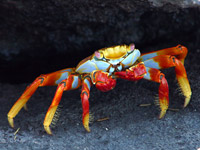 |
| The Sally Lightfoot Crab at home on Isla Santa Cruz. |
I think our guides used the first shore excursion as a tourist training exercise to teach you the comfort zones of the animals and to give you an idea of island terrain. As you approach the beach you notice how clear the water is and how fresh the air smells. The shoreline was black lava rock and dotted with bright orange Sally Lightfoot Crabs that stand out brilliantly against the black lava rock. They have only a few natural enemies here in Galapagos, which is why they can get away with their bright orange coloring. This first beach also let the fact that we were standing on volcanic rock set in. After getting back on board the Eclipse we had our first nightly de-briefing of the day and briefing on the next days events. We also explored what would be our home for the next seven days. The Eclipse was just the right size boat, with a passenger lounge/meeting room, library, dining room, sun deck and two bars. The 33 crew members on board were top notch, high marks in courtesy and helpfulness. After our self-tour we had a great meal and it was lights out.
The next day started at 6am with a wetsuit, mask and flipper fitting. It was obvious from our wet landing the day before that a little insulation was going to be needed to stay warm in 68 to 70 degree water for several hours at a time. Almost every day had swim and/or snorkel time so it was nice to have the gear. Fortified with fresh coffee and a full breakfast, we spent the morning on Santiago Island, an island once inhabited by sailors - and the goats and pigs they brought with them. Unfortunately, the domestic animals wrecked havoc on the natural fauna, so when the Galapagos Islands were named a national park, all of the residents and livestock on Santiago Island were relocated, and the pigs, donkeys, goats, dogs and cats that had become feral had to be tracked down for extermination. As we walked along paths on the island we passed by the remains of old fence posts and skulls of various farm animals - the last signs of human intrusion on Santiago.
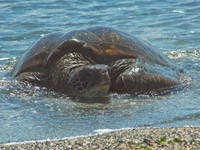 |
| Swimming with these sea turtles was incredible. |
In the afternoon we landed on the nearby island of Bartolome, using the other type of landing on the islands - a “dry” landing - dry being a somewhat relative term. These are onto a pier, a ledge above the water line, or a gangway on the side of our ship. This type of landing requires some timing - as the panga and ship seem to be floating on two different oceans and two to three feet can often separate the two. Each type of landing has its own thrills. Bartolome Island was our first look at fur seals in their natural habitat. What a strange sensation it is to not have the bars and concrete barriers of a zoo between you and one hundred seals. As we walked past, a few kept an eye on us but most were sleeping undisturbed in the warm sun. Each island has its own unique features and Bartolome Island boasts a beautiful black sand beach and a set of stairs that leads up to a 359 foot high lookout over Pinnacle Rock. Our day also included our first snorkeling outing. Most of the time we were deep-water snorkeling off the pangas - much like scuba diving without the tanks. Though the coral is not bright with colors here in the Galapagos (water gets too cold), the types and colors of the fish were fantastic. Large schools of sardines turn from sheets of silver to an almost transparent gray within a second. Angel fish and dolphin fish swim within feet of your mask - and our guide pointed out some sea cucumbers. We were also fortunate to have a fellow passenger, Stan, who has a background in marine biology, swim with us and point out some eels and octopus, which are great at the art of camouflage. Our best days of scuba diving involved the giant sea turtles - watching them feed on seaweed and several times they would surface for air and swim right up to you. Their shells feel a little slick (they only come out of the water occasionally to rest or lay eggs) but they are definitely hard. They are HUGE when swimming beside you but their slow movements and huge eyes make them very non-threatening. We also had a blast with the sea lions - they will come over to you and want to play. Our buddy, Steve, a good swimmer from England, had several underwater moves that the sea lions really seemed to like - and we joined in the fun.
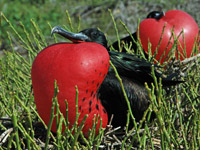 |
| In the throws of their courtship ritual, these male frigate birds are poised to impress. |
Another island, Isla Genovesa, is one of the oldest and westerly of all 13 islands. I did not realize that these islands are slowly drifting southeast and the tectonic plate they are formed on is colliding with South America. This collision continues to form new islands and the older ones are slowly eroding back into the sea. Anyhow, Genovesa has an abundance of frigate birds - and we had the unbelievable luck to be there during mating season. Even before we hit the beach you could see bright patches of red on the shore - the males puff up a bright red pouch on their chests to try to attract the females who soar overhead. The birds never gave us a second glance and continued their rituals non-stop. As one of the guides said “It is like stepping into their home, their bedroom” and she was so right. We even observed a few males being chosen. Further inland, we spotted lots of red-footed boobies and watched as rare short-eared owls snatched storm-petrels (small sea birds) right out of the air for dinner. At the same time, a few yards down the path, a Nasca Boobie was revealed and we watched as her chick hatched. A script of the life/death cycle could not have been better written.
Another day, another adventure - this one on Fernandina Island, which is home to thousands of Marine Iguanas and hundreds of Galapagos Penguins. These reptiles and birds are a great example of Darwin’s Theory of Evolution and the process of natural selection. The Marine Iguanas that arrived on the islands were at first green – not the best color when lying about on black lava rocks. Over time the ones who survived were the ones who evolved darker skin color and today they are the same black color as the rocks - they are almost indescernable as they sun themselves on the lava. The penguins still are black and white but for them, adaptation meant that downsizing was necessary - and they are now pygmies, the second smallest in the world. Even cactus and other plants have evolved to survive in the island climate. Originally, giant tortoises snacked on the cactus, which then grew protective bark on their lower appendages to avoid the tortoises. So, the tortoises changed the shape of their shell to reach higher - which the cactus responded to with even higher bark. The tortoise was last seen buying a ladder… That afternoon was spent on Isabela Island and its beach was loaded with sea turtle nests. You have to watch out for them as they appear to be nothing more than large indentations in the sand and you don’t see them until you are a few yards away. Luckily the guides steer you around the largest nest areas and they are constantly reminding you to watch your step.
One of the most interesting places was Isabela Island, as this time we went to the mangrove coves and landed amongst some of the largest lizards in the Galapagos. Orange and brown land iguanas sun bath on walking paths, so once again you have to watch your step. In fact, watching your step became almost impossible at times on this island. The guide will be pointing out a cormorant, a large bird which lost its ability to fly, and a blue-footed boobie will walk right up behind you…unaware of how oblivious and fat-footed humans can be. That afternoon our boat attracted a large pod of dolphins, which seem to take great enjoyment in swimming in the wake of our bow. The captain was kind enough to slow the boat so we could get into the pangas and take a wild ride with the dolphins. And we certainly got close! Those dolphins came within several feet of us and some would flip into the air or swim sideways so they could look you over more closely. Between everyone screaming and laughing, the boat spray soaking your clothes and the hundreds of dolphins surrounding the small rubber boat – well, it was just a kick-ass time!
And of course a cruise wouldn’t be complete without some souvenir shopping and that was accomplished on the southern side of Santa Cruz Island. This is home base for the Charles Darwin Research Station, the small town of Puerto Ayora and of course, Lonesome George. George is a giant land tortoise who is (apparently) the last of his kind. Efforts to breed him with a close cousin turned horribly wrong as he chased all of the girls away - proving he was not the kissing-cousin kind. In fact, George even turned on the scientists who were attempting to artificially breed him and only after years of patient work was one female specialist able to make progress with him. Unfortunately, she was no longer able to continue on with the Research Station and rumors of setting George back into the wild have surfaced. A lot of other good research is conducted there and young scientists from around the world request time on the islands to help out with it. There is also a giant tortoise breeding program and dozens of tortoises are released every year on select islands. A lot of thought goes into where these youngsters are placed as food, shelter and predators must all be in favorable conditions before the release can happen. For the humans, shopping must have been good as our panga rode a little lower in the water when we returned to the ship that night.
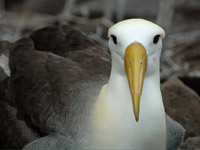 |
| A female waved albatross sitting on an egg or two |
Our last full day in the Galapagos was spent on Española Island and started with a stroll along a white sand beach that was covered with sea lions. We walked up and down the beach amongst these lazy sun bathers and they seemingly could care less if you were there. Unless, of course, after five days of being told to stay at least three feet away from large animals and someone (not Lynne or me) tried to get too personal, well an angry bark was all that was needed to keep the slow learners in-line. More open water skin diving filled out the morning and then it was back to the ship and another wonderful meal (way too many desserts as my pants no longer required a belt). That afternoon we disembarked at Punta Suarez - home to the waved albatross. Timing again is everything - the albatross were on the island for a short time to mate and nest. Amazing!
All good things must come to and end and we had to say our good-byes to fellow passengers - with the exception of two other couples, Jim and Stan and Eva and Stephan, whom we met up with in Ecuador for one more meal together. These four, along with Gillian and Steve – two very fun people from England, became our daily excursion and nightly dinner companions. It was great for us to form some friendships on the boat - and get to know people a bit deeper than as just passing acquaintances. As the good-byes were said, we did feel a little guilty (it didn’t last too long) about being the only ones not having to get up early for a long flight back home.
Looking back, Lynne and I have voted it the best out of all 28 weeks on the road - so far. The southern part of Ecuador awaits (see Ecuador entry) and then Peru.
Thoughts from Lynne
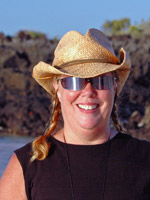 |
| One happy camper |
Ironically, not being a real nature-buff, I was not all that excited to embark on a trip to the Galapagos. I was just tagging along with Tom - and anyway, how could I go wrong hanging out on a boat with a chef for a week? Maybe it was this lack of expectations that intensified nearly every moment of discovery for me. I cannot imagine having missed this experience - it was remarkable.
A few of the highlights for me....
Sighting the Southern Cross - “When you see the Southern Cross for the first time, you understand now why you came this way…” To borrow a line from the CSN tune – the words do ring true. Standing on the deck of the Eclipse, and seeing that constellation for my very first time well, it almost seemed a dream.
Deep-water snorkeling with the giant sea turtles. So close that you could reach out and touch them. We were privileged to snorkel with many sea creatures, but the close proximity of these specific creatures brought goosebumps.
Nights on the boat, seeing the penguins dive-bomb fishing off the top deck and the sharks swimming in the running lights off the stern.
"Panga-ing" with the dolphin pods, the flight of the albatross, penguins at the equator - the list goes on...

Copyright © 2005 All content and photography are the property of Tom and Lynne Gefre.
Contact us if interested in publishing or reusing any material.